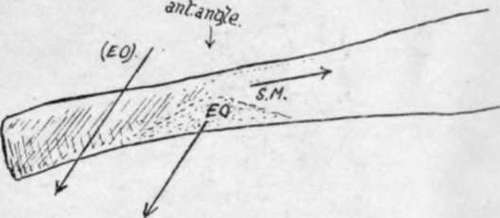Costal Cartilages. Part 2
Description
This section is from the book "The Anatomy Of The Human Skeleton", by J. Ernest Frazer. Also available from Amazon: The anatomy of the human skeleton.
Costal Cartilages. Part 2
On their outer side the ribs are covered for the most part by large flat muscles which lie on them. Fig. 39 shows these relations : the pectorals have been in great part removed on the one hand, and on the other the scapula and Subscapularis, with the exception of a strip of their inner parts, have been cut away : thus the Serratus magnus is exposed, covering the greater part of the upper eight ribs, with the External Oblique below this, covering the lower eight and the cartilages. The Latissimus dorsi lies on those ribs that are not covered by Serratus magnus above the External Oblique ; its origin is by digitations in series with those of the Serratus, but being more vertically directed it passes into a more superficial plane, first covering the ribs below the Serratus. The cartilages of the false ribs are covered by External Oblique except in front, where, the Rectus lies on them and separates them from the aponeurosis of the obhque muscle ; here the Pec-toralis major obtains some origin from the aponeurosis.
We thus see that, so far as the ribs are concerned, three large muscles cover them nearly altogether, and arise from them. Examine the line of the " anterior angles " in the articulated skeleton, and it is evident that this corresponds with the hne of interdigi-tation of External Obhque with Serratus magnus and Latissimus dorsi : in fact the bend here is apparently due to the pressure of these flat muscles, and if a well-marked " anterior angle" is examined three surfaces can be found meeting on it, as shown in Fig. 40. The lower surface is for the origin of a digitation of the External Oblique, the area in front of this is covered by the digitation of the same muscle arising from the rib next above, while the posterior area is covered by and gives origin to Serratus magnus.
Above the fifth rib the definite " anterior angle " is not so clear, but the ribs show signs, in some cases, of the origin of Pectoralis minor in front of Serratus magnus.
The digitations of Serratus magnus from the two upper ribs, on the most in-turned part of the wall, support the axillary sheath in the top of the axilla. Immediately in front of these are the pectoral structures of the anterior wall of the axilla, lying on these ribs.
Further back, the first rib is above the level of the Serratus, and is crossed here by the Scalenus posticus, which goes to the second rib under cover of the top of Serratus magnus.
Though covered by these large muscles, most of the ribs can be felt on the side of the body. By pushing the fingers up in the axilla the third rib can be reached. The second rib can only be found in front, where its cartilage is very apparent.

Fig. 40.-Anterior angle of a middle rib : the arrows show the direction of fibres of External Oblique, some arising from the rib and making the lower surface, others coming from the bone above and thus pressing in the front part of the rib. Serratus magnus arises from the posterior area, runs in the direction ol the arrow S.m. and moulds the rib lying under it.
Now look at the thorax from behind. The large flat muscles only cover the outer aspect of the ribs, and the surface pertaining to them only extends to the hne of the angles of the bones : internal to this line the ribs are covered by the muscles of the Erector spinae group, and even outside the line the upper and lower ribs are covered by the Serrati postici passing to their attachments on them. The hne of the angles is not vertical: it is furthest from the middle line usually on the eighth rib, and turns in above and below this, so that it practically coincides with the tubercle on the first rib and thus brings the outer border of the muscle group up to their insertions on the cervical transverse processes. In the same way, below the eighth rib, the width of the muscle mass decreases toward that of the back of the sacrum.
Now observe the change in the relations of the ribs that results from movement of the scapula. That bone covers the second to the seventh rib, but is separated from them by Subscapularis and Serratus magnus. When the shoulders are " brought together " the vertebral margin of the scapula and its attached structures may ride over the post-vertebral fascia, so that Serratus magnus covers the bones as far as the angle. fBut when the angle of the scapula is brought outwards and the whole bone rotated, as in raising the arm above the shoulder, the Serratus magnus and vertebral border come away from the angles, and the Rhomboid muscles get into relation with that portion of the bones that was formerly covered by Serratus magnus external to the angles of the ribs : this can be appreciated by rotating the scapula on its clavicular attachments in the skeleton. Owing to the presence of the scapula, the upper ribs cannot be directly examined from behind. Below the seventh, however, the ribs can be felt, though the twelfth is often impalpable in women.
Continue to:
